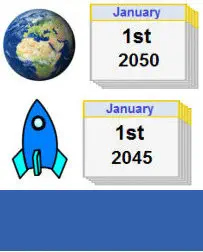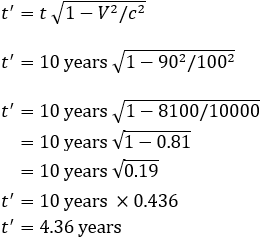
SuperFast Guide to the Time Dilation Formula
Advertisement

Quick and easy summaries of relativity and related subjects
Time dilation occurs as a consequence of a difference in relative speed between two
observers (Special Relativity) or a difference between two distances from a
gravitational source (General Relativity). Here, we will focus on a difference in speed
and work through the formula in a quick and easy way.
Here is the time dilation formula:

Time Dilation - How time changes for anything moving
More Time Dilation Examples - A more detailed set of examples and working

SuperFast Guide to the
Time Dilation Formula

The work-through below shows how the formula can be used to calculate the
difference in elapsed time between a stationary clock and a clock at high speed, such
as on a rocket. In this example the journey time (t) as viewed from Earth is 10 years
and the speed of the rocket (V) is 90% of the speed of light (c) which is very close to
300,000 km per second, or 186,300 miles per second:
Write the formula down.


Work through and reduce the
equation until you arrive at the
answer.
Note that years was used in this
case but we could have used any
time period such as days or
seconds etc.
Plug in 10 years for t. Add the
percentages of the speed and the
speed of light (90 and 100).
In the example above a stationary observer, such as someone on Earth, would see
that the rocket has taken 10 years to reach its destination, while a person on the
rocket would measure that only about 4 years and 4 months has passed. Note that
both observers would feel their own time passing normally.
A question then arises as to why it’s the person on the rocket that has experienced
the time dilation and not the Earth-bound observer. The answer is to do with whoever
accelerates away from the other and is explained on the Twin Paradox page here.
Suggested further reading:
[ Special Relativity ] [ General Relativity ] [ Einstein ] [ Time Dilation ]
[ Black Holes ] [ Twin Paradox ] [ Time Dilation Formula ]
[ Special Relativity ] [ General Relativity ] [ Einstein ] [ Time Dilation ]
[ Black Holes ] [ Twin Paradox ] [ Time Dilation Formula ]
Advertisement

Quick and easy summaries of relativity and related subjects

[ Special Relativity ] [ General Relativity ] [ Einstein ]
[ Time Dilation ] [ Black Holes ] [ Twin Paradox ]

[ Special Relativity ] [ General Relativity ] [ Einstein ]
[ Time Dilation ] [ Black Holes ] [ Twin Paradox ]

SuperFast Guide to the Time Dilation Formula
Time dilation occurs as a consequence of a difference in relative
speed between two observers (Special Relativity) or a difference
between two distances from a gravitational source (General
Relativity). Here, we will focus on a difference in speed and work
through the formula in a quick and easy way.
Here is the time dilation formula:

The work-through below shows how the formula can be used to
calculate the difference in elapsed time between a stationary
clock and a clock at high speed, such as on a rocket. In this
example the journey time (t) as viewed from Earth is 10 years
and the speed of the rocket (V) is 90% of the speed of light (c)
which is very close to 300,000 km per second, or 186,300 miles
per second:

Note that years was used in this case but we could have used any
time period such as days or seconds etc.
In the example above a stationary observer, such as someone on
Earth, would see that the rocket has taken 10 years to reach its
destination, while a person on the rocket would measure that only
about 4 years and 4 months has passed. Note that both
observers would feel their own time passing normally.
A question then arises as to why it’s the person on the rocket that
has experienced the time dilation and not the Earth-bound
observer. The answer is to do with whoever accelerates away
from the other and is explained on the Twin Paradox page here.
Suggested further reading:
Time Dilation - How time changes for anything moving
More Time Dilation Examples - A more detailed set of
examples and working
The Time Dilation Calculator - See how long it takes to reach
the stars - An easy calculator with examples to try.









